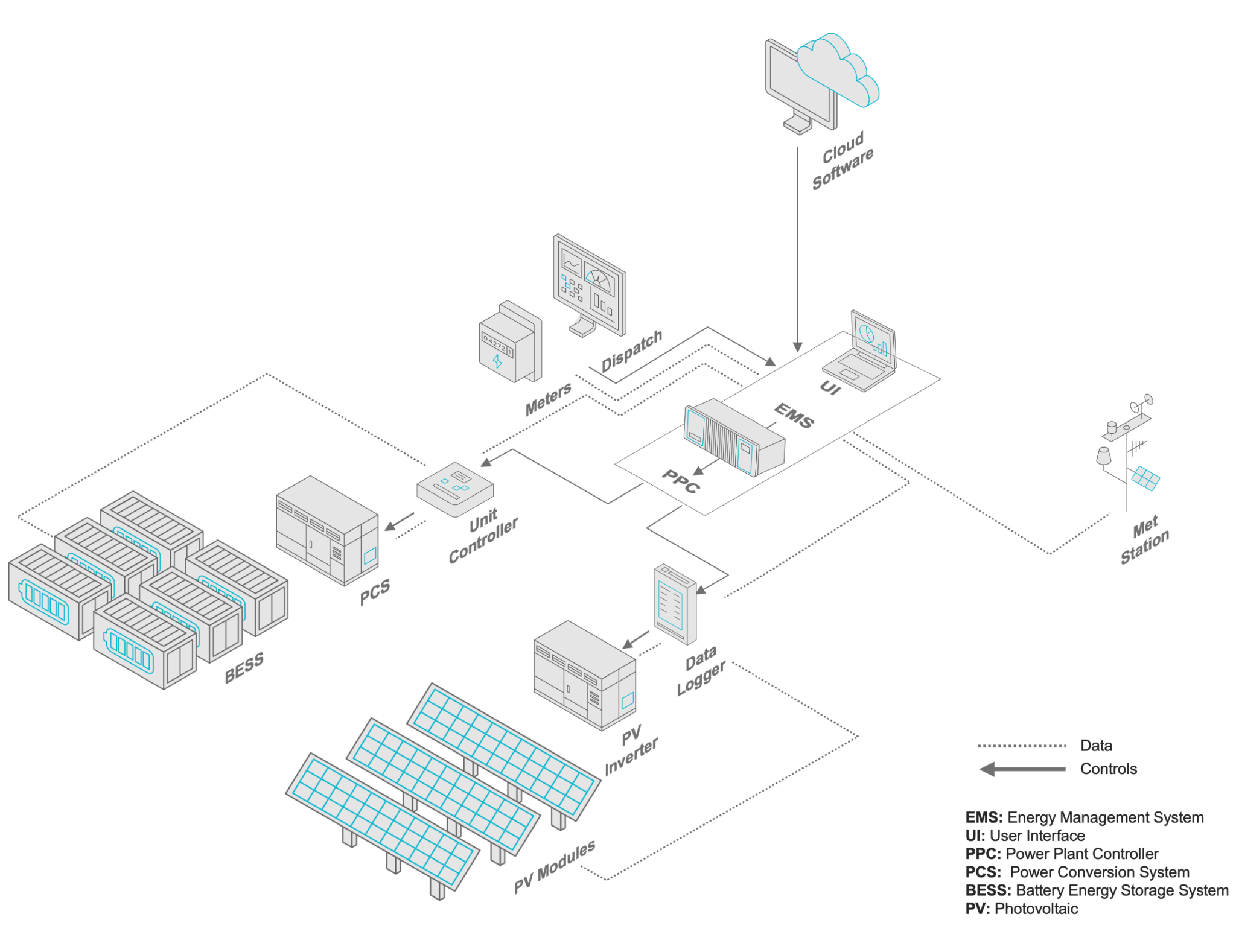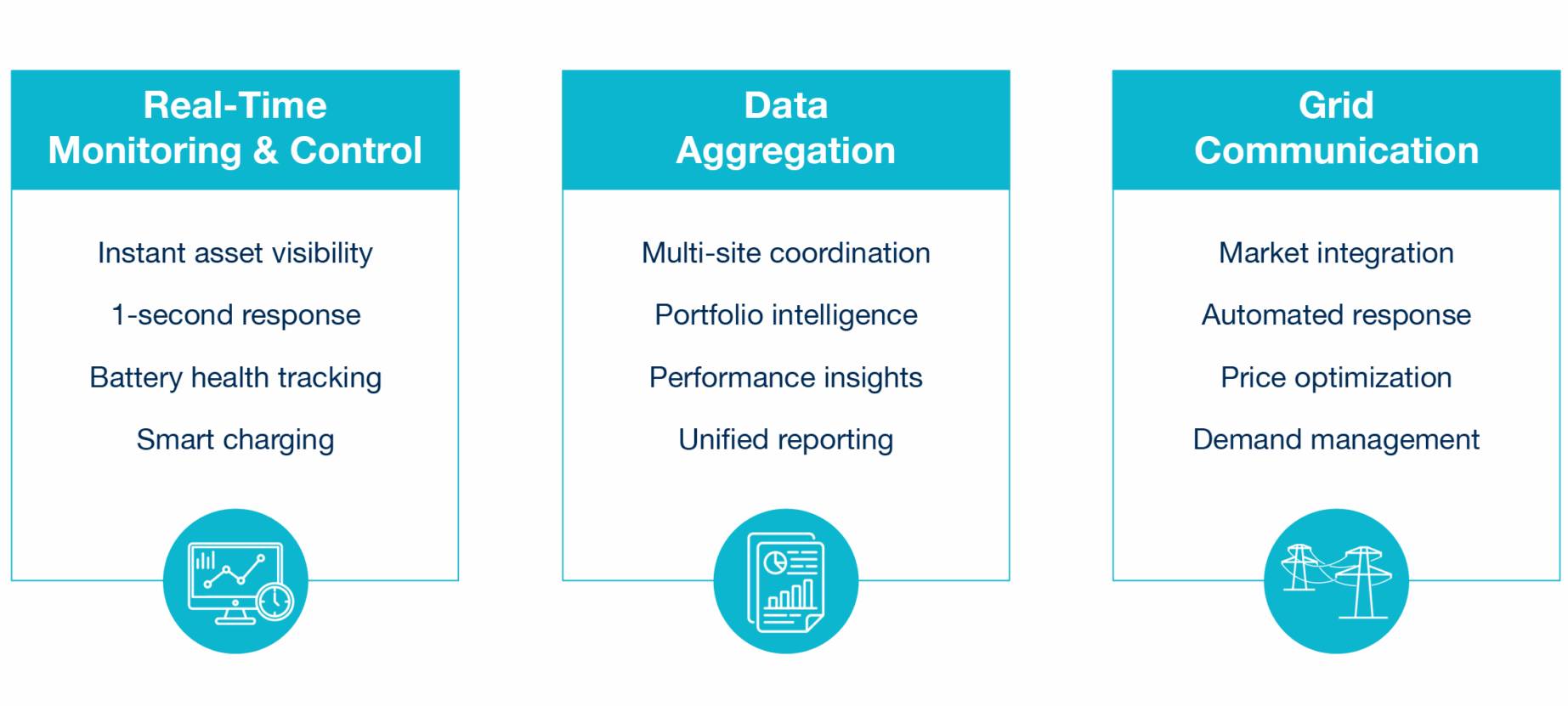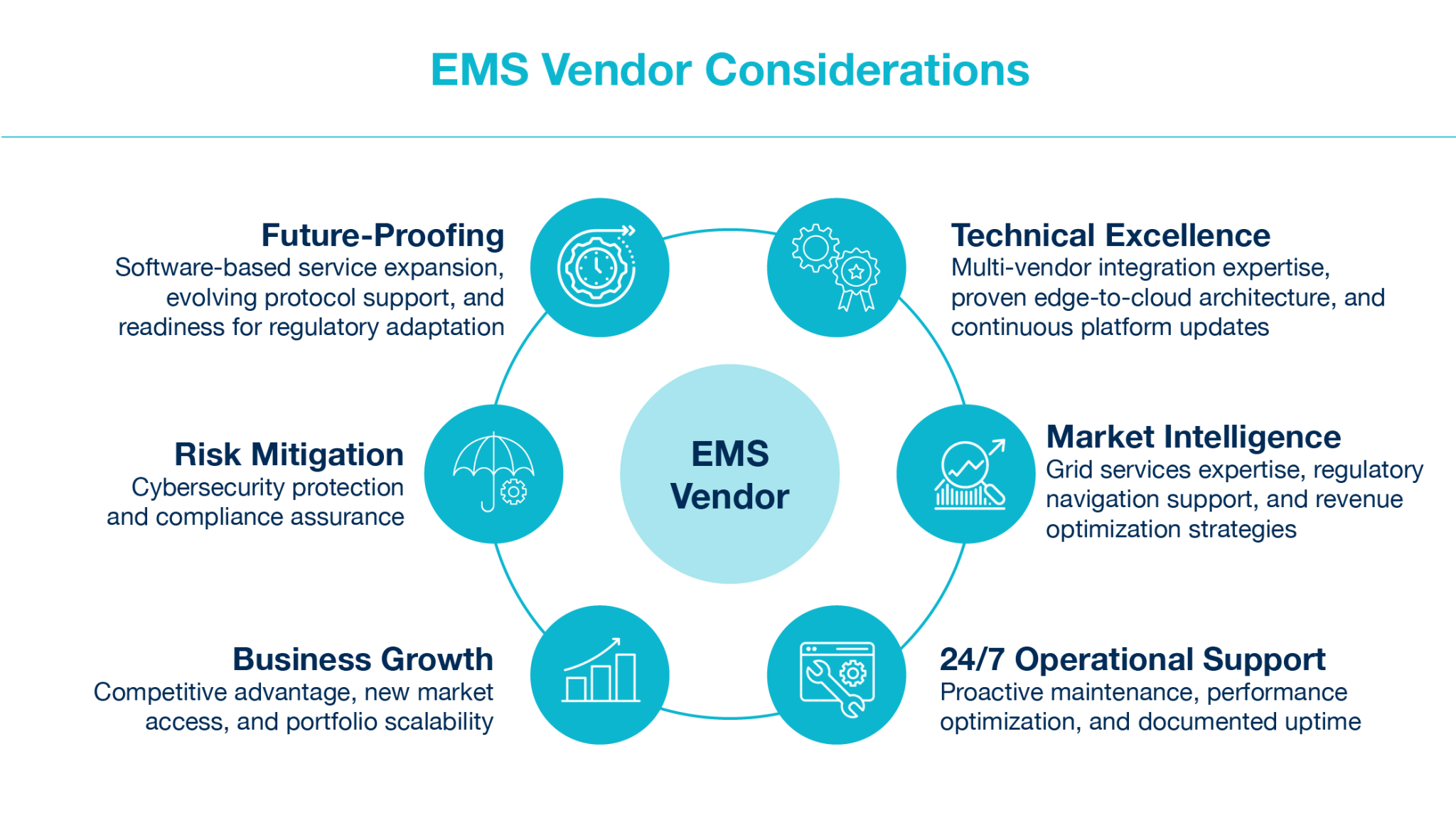Executive Summary: Energy management systems deliver critical capabilities for battery storage and hybrid projects, enabling developers to maximize revenue through grid services participation, ensure compliance with interconnection requirements, and optimize asset performance over 15-20 year operating periods.
A Guide for C&I and Utility-Scale Solar, Hybrid, and Energy Storage Projects

As the power grid experiences increasing demand and reliability pressures, energy storage at the commercial and utility scale is expanding. The convergence of improving battery economics and growing need for grid flexibility has created new opportunities and technical challenges for project developers.
Battery projects require sophisticated control systems to operate effectively. Energy management systems (EMS) have emerged as critical infrastructure, providing the real-time coordination needed for grid services, performance optimization, and safe operation—all with sub-second response times that modern grid requirements demand.
This guide will cover the fundamentals of energy management systems: what they are, when your project needs one, and how to determine if a full EMS makes sense for your specific application. Whether you’re developing your first storage project or adding batteries to an existing solar installation, understanding EMS requirements is crucial for maximizing returns and ensuring grid compliance.
What is an energy management system? At its core, an EMS is the brain of a renewable energy operation. It’s a computerized system that serves as the critical link between on-site equipment and remote infrastructure—connecting your physical assets to your team and their daily workflows, and powerful servers that host cloud applications to process data, run optimization algorithms, and enable portfolio-wide control from anywhere. The EMS coordinates battery monitoring, grid services, and revenue optimization while monitoring, controlling, and optimizing energy resources in real-time.
Edge to Cloud Architecture
A complete EMS solution operates on two levels that work together seamlessly: an edge controller (the core EMS) that acts as the on-site ‘traffic cop’ for real-time operations, and a cloud platform that provides portfolio-wide intelligence and remote management. While ‘EMS’ can refer to the edge component alone or the full system, modern energy management requires both levels working in concert.

Edge Controller (On-Site Intelligence): The edge controller is your local operations manager, handling real-time decisions right at the battery site. It manages:
- Battery Status Monitoring: Continuously monitors state of charge (SOC), state of health (SOH), and thermal conditions to keep batteries operating safely
- Grid Service Coordination: Runs control algorithms for frequency regulation, volt-var support, and other grid support services
- Local Optimization: Makes split-second scheduling decisions to maximize performance
- Device Integration: Communicates with battery management systems (BMS), power conversion systems, and utility equipment
Cloud Platform (Remote Intelligence): The cloud component provides a broader view, access to advanced applications, and strategic control across your entire portfolio:
- Remote Dispatch: Can send power commands, SOC targets, and operational schedules to edge controllers. Your local grid code will define the dispatch controls needed through specified devices, and this is dependent on your regional grid operator’s requirements and local regulatory framework
- Performance Intelligence: Optimizes battery lifecycle and schedules predictive maintenance
Seamless Communication: These two layers stay connected through industry-standard protocols (DNP3, Modbus, OPC-UA, IEC 61850, IEC 60870) that ensure:
- Real-time data exchange with sub-second response times for critical parameters
- Remote configuration capabilities
- Automatic failover for uninterrupted operations
This architecture gives you the best of both worlds: fast local response when milliseconds matter, plus sophisticated cloud analytics for long-term management and revenue maximization.
Core EMS Functions

Battery storage requires three specialized management capabilities that basic monitoring systems cannot provide.
- Real-time monitoring and control of all connected assets: This instant visibility allows you to identify and address performance issues immediately, preventing costly downtime and ensuring your assets operate at peak efficiency. Device management includes continuous tracking of battery state parameters using chemistry-specific algorithms, real-time monitoring systems that provide visibility into operating conditions and potential fault states, and intelligent charging protocols that maximize battery life and warranty compliance. This includes integration with battery management systems for cell balancing, thermal management, and performance coordination. With 1-second data access, you can make informed, confident operational decisions based on actual conditions.
- Data aggregation from multiple sources: For multi-site operations, EMS provides centralized intelligence that synthesizes all internal asset data into a unified view. This includes collecting and harmonizing data from diverse sources—weather stations, meters, inverters, battery systems, and auxiliary equipment—into a single operational picture. The system enables performance benchmarking across sites, tracks degradation patterns, identifies underperforming assets, and generates consolidated reports for O&M teams. By aggregating historical and real-time data across your entire fleet, operators can spot trends, predict maintenance needs, and optimize asset performance at both site and portfolio levels.
- Communication with grid operators and energy markets: Seamless integration with external systems—such as optimization and energy market analytics platforms—ensures you can participate in lucrative grid services and respond to market signals without manual intervention, opening new revenue streams that would be impossible to capture manually. An EMS can translate your assets’ capabilities to what the grid needs—handling the complex protocols required for market participation and supporting compliance with performance requirements. This external connectivity transforms your storage assets from passive equipment into active market participants.
When Do You Need an EMS?
Not every renewable project requires a full EMS, but every project including battery storage, and some more complex solar only projects, require dedicated EMS capabilities such as:
- Grid services applications such as frequency regulation, voltage support, and energy arbitrage demand specialized battery control algorithms that basic monitoring cannot provide.
- Additional revenue optimization strategies when paired with specialized software or services. While an EMS provides the control infrastructure and real-time responsiveness needed for peak shaving and load coordination, the actual optimization intelligence typically operates through separate algorithms or specialized trading teams that leverage the EMS’s capabilities.
- Hybrid solar-plus-storage projects, which need coordinated management between solar generation and battery operations, especially with shared POI constraints. Multi-application projects combining backup power, grid services, and demand management require integrated control systems.
Traditional solar installations without storage function well with monitoring-focused solutions. Solar performance monitoring, basic grid interconnection through standard inverter controls, and data collection for performance analysis typically provide sufficient capability for solar-only projects without the complexity of battery management.
Simple applications with minimal control requirements include single-purpose storage focused solely on backup power, small-scale projects under 1 MW with straightforward applications, and development phase projects where basic monitoring suffices until final system requirements are defined.
EMS Selection Criteria
Selecting whether to implement an EMS requires evaluating both immediate technical requirements and long-term business strategy. Consider these key factors:
Business and Market Drivers
- Growth trajectory: Plan for evolution from pure solar to hybrid projects and scaling from single sites to portfolio-wide operations
- Regional market opportunities: Evaluate new ancillary service programs and grid operator requirements that create revenue streams
- Regulatory evolution: Assess upcoming interconnection standards and grid services participation requirements (FERC 841, IEEE 1547, EU Network Codes, VDE-AR-N 4110/4120/4130)
- Storage integration potential: Analyze existing PPA flexibility and potential economic improvements from battery additions
EMS Vendor Evaluation: Focus on providers with proven operational track records and market expertise in related technologies, documented uptime statistics, and demonstrated revenue generation through actual grid services participation. The right EMS partner will help you meet today’s requirements while positioning you to capitalize on opportunities in increasingly complex energy markets.
The Strategic EMS Decision

Battery energy storage projects represent significant capital investments requiring returns over 15-20-year operating periods. These sophisticated systems demand specialized EMS capabilities that only experienced providers with deep technical expertise and proven staying power can deliver. The complexity of modern battery controls—from cell-level safety to advanced grid services—requires continuous development investment that basic monitoring platforms simply cannot match. As grid services markets expand and storage becomes central to grid operations, projects will need EMS partners with the technical depth and long-term commitment to support evolving requirements throughout their multi-decade lifecycle.
For developers transitioning from solar-only to storage projects, EMS represents both a technical requirement and a strategic advantage. The right edge-to-cloud EMS platform enables participation in high-value grid services markets while ensuring comprehensive, reliable operations that protect long-term investment value.
Ready to discuss your battery storage project’s EMS requirements? Learn how PowerTrack EMS delivers proven edge-to-cloud capabilities for commercial and utility-scale battery energy storage projects. As part of Stem’s comprehensive PowerTrack suite and end-to-end project solutions, our EMS integrates seamlessly with the full spectrum of services needed to bring your project from concept to commercial operation. Complete the Let’s Talk contact form below to connect with our storage specialists.
FAQ
- What is the difference between EMS and SCADA for battery storage? While SCADA (Supervisory Control and Data Acquisition) systems provide basic monitoring and control capabilities, an EMS goes further by offering real-time optimization, advanced analytics, and automated decision-making for battery storage. EMS can coordinate multiple revenue streams, respond to market signals in under 1 second, and manage complex grid services that SCADA alone cannot handle. For solar installations, SCADA may suffice, but battery storage projects typically require the sophisticated control capabilities of an EMS.
- What size energy storage project needs an EMS? The need for an EMS depends more on your revenue strategy than project size. While larger battery storage projects typically require full EMS capabilities, smaller projects targeting advanced grid services or multiple revenue streams often justify the investment too. The key factors are operational complexity and market participation goals—hybrid solar-plus-storage sites, multi-site portfolios, and projects in sophisticated ancillary service markets typically need an EMS regardless of size. Your local market regulations, grid operator requirements, and future revenue stacking plans ultimately determine whether an EMS makes economic sense for your specific project.
- Can you add an EMS to an existing solar installation? Yes, an EMS can be retrofitted to existing solar installations, especially when adding battery storage. The process involves installing edge components (communication interfaces, data loggers) at the site and integrating with existing inverters and equipment. This retrofit approach is increasingly common as solar developers add storage to capture additional revenue streams.